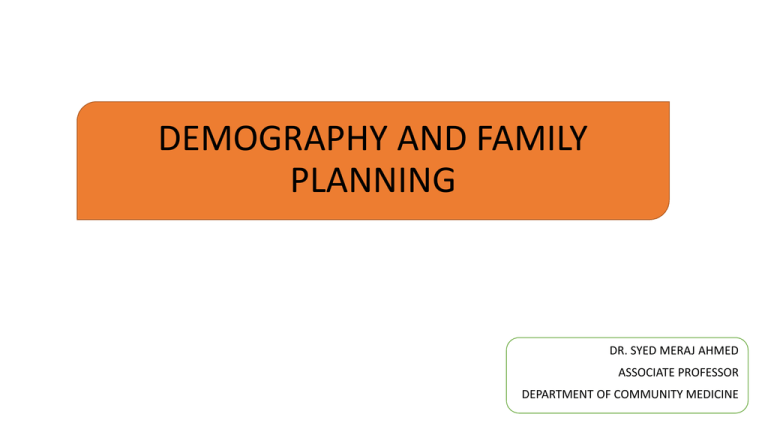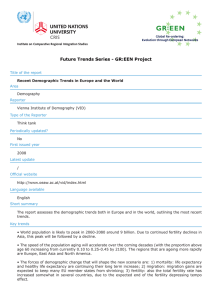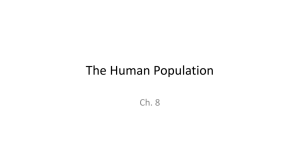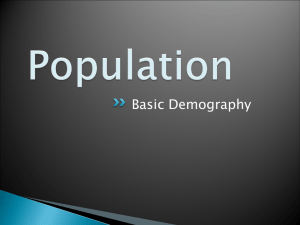Demography and Family Planning
advertisement

DEMOGRAPHY AND FAMILY PLANNING DR. SYED MERAJ AHMED ASSOCIATE PROFESSOR DEPARTMENT OF COMMUNITY MEDICINE By the end of this session, the students should be able to: • Describe demography cycle • Discuss the demographic trends in KSA • Describe family, community and family size. • Explain the fertility related statistics What is demography Demography is the scientific study of human population. It focuses its attention on the following three observable human phenomenon: Change in population size (growth or decline) Composition of population Distribution of population in space. FERTILITY MIGRATION DEMOGRAPHIC PHENOMENA MORTALITY SOCIAL MOBILITY MARRIAGE These are known as demographic processes. What is a demographic cycle The demographic cycle, or population cycle, refers to the evolution over time of the population profile of a country, region or other defined geographical area. A population cycle theory has been postulated in terms of the socio-economic history of industrialized countries. Four stages of demographic cycle based on the population High stationary • High birth and high death rates and relatively low population 2 Early expanding • Uneven population density due to increased urbanization and industrialization 3 Late expanding • The birth and death rates are much lower resulting in a relatively steady population growth 4 Low stationary • An actual decline in the total population of a country due to an excess of deaths over births. 1 DEMOGRAPHY TRENDS IN SAUDI ARABIA POPULATION SIZE: GROWTH RATE 1980 9.8 million people 2010 27.3 million people 2040 40.4* million people 5.98% 1.63% 4.07% 1.98% 0.50*% TOTAL FERTILITY RATE LIFE EXPECTANCY YEAR 1980 – 1985 1995 – 2000 2000 – 2005 2010 2045 – 2050 (children per women) MALE FEMALE 1980 - 85 63.3 66.8 2005 - 10 72.8 76.4 2045 - 50 80.9* 83.0* 1980 – 85 2005 – 10 2010 – 15 2045 – 50 7.02 3.03 2.68* 1.78* Changing age structure in Saudi Arabia Changing age structure in Saudi Arabia Elderly population of Saudi Arabia FAMILY “Family is a group of persons united by the ties of marriage, blood or adoption; constituting a single household, interacting and inter-communicating with each other in their respective social roles of husband and wife, mother and father, son and daughter, brother and sister creating a common culture” – Burgess and Locke TYPE OF FAMILY PATRIARCHAL FAMILY MONOGAMOUS FAMILY MATRIARCHAL FAMILY POLYGAMOUS FAMILY NUCLEAR FAMILY POLYANDROUS FAMILY EXTENDED NUCLEAR FAMILY MATRILINEAR FAMILY JOINT FAMILY PATRILINEAR FAMILY THREE GENERATION FAMILY ENDOGAMOUS FAMILY PATRILOCAL FAMILY EXOGAMOUS FAMILY MATRILOCAL FAMILY BROKEN FAMILY PROBLEM FAMILY WHAT IS A COMMUNITY Community is a human population living within a limited geographical area and carrying on a common interdependent life. Types of community: 1) Rural community 2) Urban community RURAL COMMUNITY URBAN COMMUNITY JOINT FAMILY NUCLEAR FAMILY MORE ARRANGED MARRIAGE MORE DIVORCES FEMALE LITERACY IS LESSER FEMALE LITERACY IS HIGH SENSE OF NEIGHBOURHOOD NOT IMPORTANT SENSE OF WE FEELING NOT SEEN SOCIAL INTERACTION IS PERSONAL NO OR LIMITED SOCIAL INTERACTION CULTURE IS CONSERVATIVE COSMOPOLITAN CULTURE CHARACTERISTICS OF A COMMUNITY: Has one or more roles that define its identity within society. Has a set of goals - provides a sense of direction. Is organized within a set of formal/informal beliefs, values, expectations and behaviors that defines the boundary of the community. There is some form of communication between members. Has skills and resources that are shared between the members. Balance the needs of the community with the needs of its members. FERTILITY RELATED STATISTICS The average annual number of births during a year per 1,000 persons in the population at midyear; also known as crude birth rate. No. of live births during the year Birth Rate = --------------------------------------------Estimated mid year population Saudi Arabia (1431) – 23.3 × 1000 FERTILITY RELATED STATISTICS The number of resident live births for a specified geographic area during a specified period divided by the female population age 15-44 years for that area multiplied by 1000. No. of live births during the year General Fertility rate = --------------------------------------------------Estimated mid year female population age 15 – 44 years in the same year × 1000 FERTILITY RELATED STATISTICS The number of resident live births for a specified geographic area during a specified period divided by the married female population age 15-44 years for that area multiplied by 1000. General Marital Fertility Rate No. of live births during the year = --------------------------------------------------× 1000 Estimated mid year married female population age 15 – 44 years in the same year FERTILITY RELATED STATISTICS The number of births occurring during a given year or reference period per 1,000 women of reproductive age classified in single-or five-year age groups. No. of live births in a particular age group during the year Age specific Fertility Rate = --------------------------------------------Estimated mid year female population of the same age group × 1000 FERTILITY RELATED STATISTICS The number of children who would be born per woman (or per 1,000 women) if she/they were to pass through the childbearing years bearing children according to a current schedule of age-specific fertility rates. Ʃ Age specific fertility rate (ASFR) Total Fertility Rate = OR 5 Ʃ Age specific fertility rate (for 5 – year age group) Saudi Arabia (1431) – 2.98 TFR= 5 (.051 + .196 + .208 + .147 + .075 + .024 +.004) = 3.53 Where: the figures in parentheses are age-specific rates for the 15-19, 20-24, ... , 45-49 age categories, respectively. FERTILITY RELATED STATISTICS Average number of daughters that would be born to a woman if she passed through her life-time from birth to the end of her reproductive years conforming to the age-specific fertility and mortality rates of a given year. Net Reproduction = Rate (NRR) No. of girls born and survived ----------------------------------No. of women who survived after the end of the reproductive life FERTILITY RELATED STATISTICS - others Child women ratio Pregnancy rate Abortion rate Marriage rate Abortion ratio





